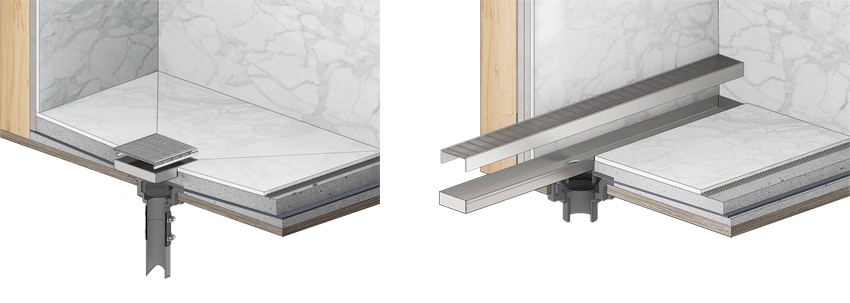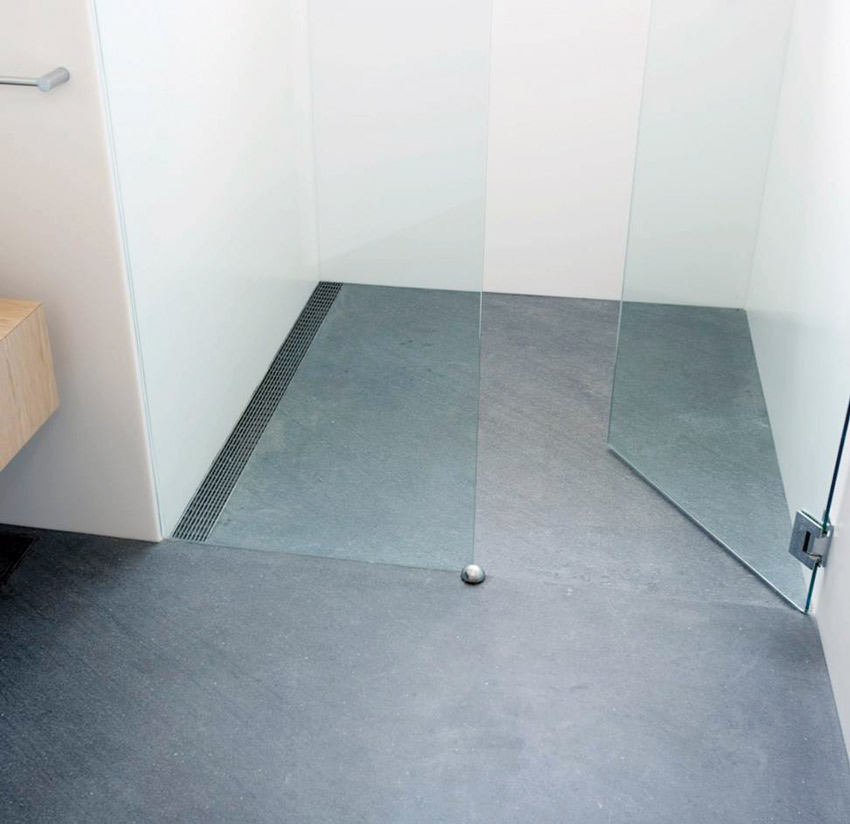Latest and Greatest Features in Linear Drains, Wall Coverings, and Flooring
Drain Options: Linear vs. Traditional
There are essentially two types of shower drains available on the market today. The traditional center-placed drain and the linear drain. Traditional center-placed drains require that the shower floor feature a four-way pitch, creating a 360-degree bowl around the drain. Linear drains are often positioned along a wall or along the threshold of the shower enclosure. The shower floor slopes in one direction, instead of four, toward the drain.
One of the advantages to using a linear drain in a barrier-free hospital shower area is that the linear drain can serve as the floor drain for the entire bathroom. This is useful because without a physical boundary, such as a curb, to keep water from moving beyond the boundary of the shower area, often referred to as a wet area, to the dry area where the sink and toilet are located, it is practical to waterproof the entire room and equip the wet room with a floor drain. Traditional center-placed drains must be located in the center of the shower compartment and are ill-equipped to manage water that escapes beyond the boundary of the shower space.
There are three important design considerations when using a linear drain to create a barrier-free shower space: create a wall-to-wall fit, provide the necessary pitch in the floor to direct water toward the drain effectively, and achieve equal floor heights between the shower area or wet room and adjacent rooms.

Images courtesy of Infinity Drain
There are two common types of drains: traditional center-placed drains and linear drains.
Wall-to-Wall Fit
The linear drain is often placed along the threshold of the shower to create the barrier-free or curbless shower. When designing a bathroom with the linear drain in this location, it critical that the linear drain achieve a wall-to-wall fit. If the drain is too short, and there is a gap, water can run from the shower into the surrounding space. If the drain is too long, it will be impossible to install, as it cannot be installed through a wall. Avoid installation issues by identifying the finished wall-to-wall dimension and ensure that the linear drain is sized appropriately.
Appropriate Floor Pitch
The pitch of the floor is responsible for directing the water to the drain and out of the space. The typical recommended slope in the shower is 1/4-inch rise per foot. The recommended slope on the dry side of the space is a more gradual 1/8-inch rise per foot.
Consistent Floor Height
Creating a consistent floor height from one area to the next is a basic tenet of good design. In hospitals and other spaces where the mobility of occupants may be limited, consistent floor heights that are easy to navigate are especially important.
When designing a barrier-free shower, the depth of the linear drain is a significant contributor in determining the final height of the floor. Deeper drains require more buildup to accommodate and result in greater floor heights, which may require that designers create a more managed transition to help occupants move from one floor height to the next. Shallower drains can help to keep floor heights low, making the transition to other spaces easier.

Photo courtesy of Infinity Drain
Shallower drains make it easier to keep the floor heights consistent between the wet area in a bathroom and adjacent areas.
The Waterproofing Myth
Many designers believe that any drain will work in any type of waterproofing. This is untrue, and pairing a waterproofing technique with an unsuitable drain can have disastrous effects on the jobsite. It is critical to be aware of the waterproofing technique that will be used by the project team and select a linear drain accordingly.
Here is a basic description of the two different types of waterproofing and why they affect drain selection. The two types of waterproofing are referred to as traditional waterproofing and modern waterproofing. The modern waterproofing technique uses materials that make it possible to tile directly on top of the waterproofing surface, which saves a lot of floor height and can accommodate a shallower linear drain. It is also easier to waterproof an entire space with the newer method because the waterproof membrane is simply painted or laid on. Traditional waterproofing materials require an additional mortar layer between the waterproof surface and the tile, which adds thickness, and the typical waterproofing membrane is a pan liner, which is nearly impossible to form to accommodate an entire bathroom area in order to create a wet room.
A hybrid of these traditional and modern waterproofing techniques also exists and is often used in hospitals and health-care facilities. This method uses a waterproof sheet that must be clamped to a drain. The waterproof sheet is also used as the final flooring throughout the entire bathroom. This allows for a seamless waterproofing room with minimal buildup. Common materials for these applications include vinyl “safety flooring,” epoxy coatings, and others.
Notice

www.gerflorusa.com

www.infinitydrain.com

www.inprocorp.com









